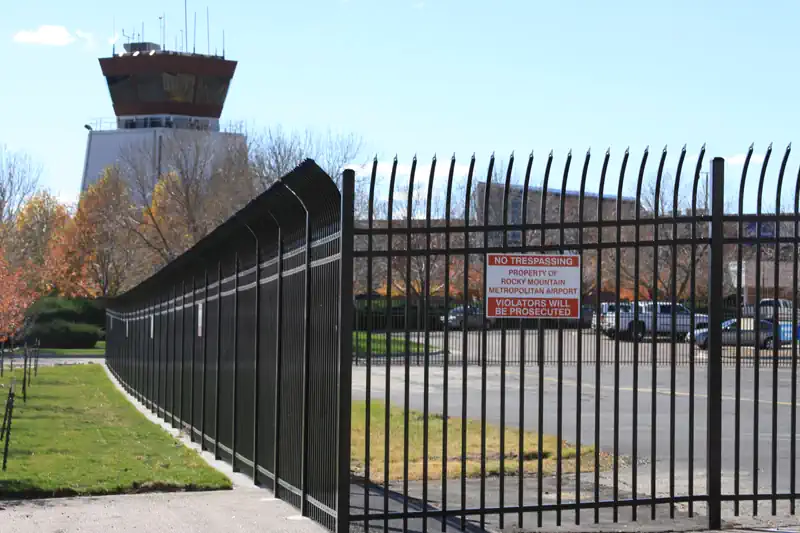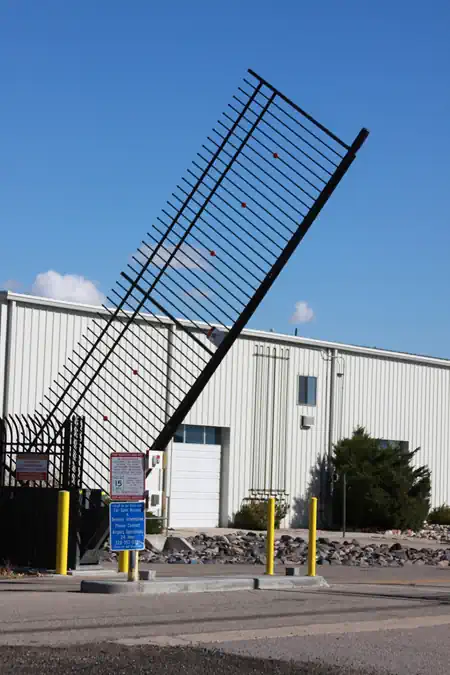
Automatic Vehicle Gates
Electric gates, automatic gates, actuated gates…. all these names are associated to one of the most common commercial gates, the automatic gate.
Designing and installing an Automatic gate
One of the hardest decisions regarding a vehicle gate is whether to install it to operate automatically. This can be an extremely critical decision affecting the effectiveness of a gate and its longevity. Most property owners don’t know the pros and cons of automatic gates and simply use cost to determine whether a gate is manual or automatic.
Understandably cost can be a critical factor determining your gate power source however, this article will help you understand some of the other things to consider with automatic gates.

Power Source
The key difference between a manual and automatic gate is the power source to open and close. Manual gates use human power while automatic gates use electrical power, hence the common designation of electric gate.
Power reliability with automatic gates is almost bullet proof. Almost, because most automatic gates rely on electric power to operate and anyone in an area with intermittent electrical supply understands what happens to the automatic equipment when there is no power. That being said, there are ways to help ensure an automatic gate still operates when the electrical power grid is down. Battery backups and solar power backups or are the two most common ways to keep your automatic gate operating.
Safety
In a commercial or industrial setting manual operating gates can be extremely dangerous and an expensive liability to your company. An individual intending to operate a manual gate has to enter the flow of vehicle traffic in order to open or close a gate. This could lead to an accident involving both vehicle and pedestrian. Additionally, if your gate is heavy, the individual opening or closing the gate could become injured in the act of moving the gate due to the shear weight and resulting strain on their body. Furthermore, the gate itself could come free of the individual’s control and strike the individual, passersby or even vehicles or other property. Automatic gate remove these dangers while ensuring your facility is secure.
Security
Manual gates use both your power to open and close AND to lock. Automatic gates however, use power to open and close AND to lock in either the open OR closed position. Often overlooked, this can be of great importance if your gate needs to be secure in either the open or closed position WITHOUT manual intervention. Securing your gate using an automatic operator can also help keep the gate out of harms way from vehicle traffic or from weather, such as gust of wind that can send manual gates slamming into their fence or any objects in their way such as pedestrians or employees. Often overlooked and simply an extravagant spend, automatic gates can actually save your company money in the long run in accident avoidance.
Gate Types
All gates can be manual or automated, some more easily than others. For the sake of this article we will discuss the most common automated gates:
- The most popular automatic gate is a full cantilever. This design requires both the space to locate an operator and room to slide the gate back behind an adjacent fence line.
- The second most popular is a swing gate. This design requires the space to locate the operator, the room to nest the gate along the adjacent roadway AND the space and clearance to swing the gate through the roadway and out of the way.
- The third most common automatic gate is the vertical pivot gate. This drawbridge style gate is the most expensive because of the mechanical design of the gate and hydraulic operator necessary to move the gate up and down. Pivot gates require a larger location to install the operator. However, unlike full cantilever and swing gates, pivot gates do not take up additional space in the opening or closing action or in the fully open position, except vertically. So how do you choose between these three major types?
Narrow Necked-down Driveways
If your driveway and adjacent fence lines necks-down to a narrow opening, without adequate fence space to either side, you cannot install a semi cantilever gate. A swing gate or pivot gate are your best options. If the area is also obstructed vertically then a pivot gate is out of the question and your best solution is a swing gate.
Short Driveways
If your driveway apron is short, preventing vehicles from waiting some distance from your gate to open, then a swing gate is not your option. Additionally since most swing gates do not open fully, resting on the adjacent fence panels, instead open 90 degrees or more to their closed position, if your driveway apron is such that a swing gate would obstruct vehicles or pedestrians in the open position, then again a swing gate is not a good option for you. Another obstacle to swing gates are pitched driveways. If your driveway pitches to either side and there are obstructions, either geographic or man-made, a swing gate might not work. Pivot gates might therefore be your best solution.
Vertical Obstructions
Pivot gates excel except when there are obstructions overhead. Power line and trees are the most common obstructions however signs and light poles might also prevent installing a pivot gate. When vertical obstructions exist then a full cantilever or swing gate might be your best option. Additionally, Pivot gate operators can take up to three times the space needed for a more traditional operator. If space is a constraint for locating a pivot gate operator, then again, swing or full cantilever might be your best option.
Safety Devices and Automation Integration
In addition to advances in gate design, lending more to automated gates than ever before, there are also new safety measures and automation integration devices that help automated gates become and even safer and more secure solution.
Vehicle Proximity Sensors
Traditional gate loops buried below or cut into the driveway can be unreliable over time. Also, photo eyes can be easily compromised due to weather or debris. New to the automatic gate industry are vehicle proximity sensors. These safety devices uses microwaves to detect vehicles and are therefore not obstructed by weather or damaged overtime along with driveway conditions. They are slightly more complicated to install and setup however the payback can be great with longevity and peace of mind.
Smartphone Integration
Most of the major operator manufacturers offer ways to integrate an automatic gate into your security and access control systems. New to the market however, are smartphone applications that can allow you to control your gate, schedule operation or even review history and setup alarms associate with operation. Gone are the days of having to jump in your vehicle or call an employee after hours to close your gate. With a push of a button on your phone app, your gate is open or closed. Imagine that!
When it is all said and done, there are no right or wrong answers to generalize automatic gate design and installation, only your answers. Every gate is different and only the true professionals can help guide you to the best solution for your application. Time and time again Lifetime Fence is called to help diagnose or replace a bad automatic gate. Most of the time an automatic gate was improperly design and poorly installed.

